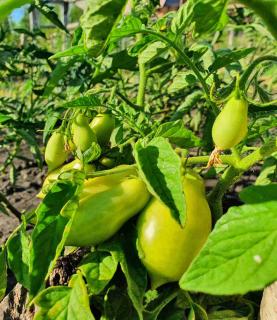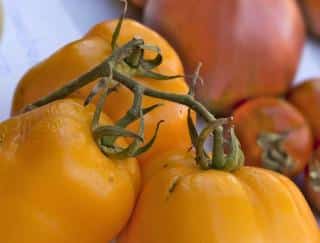

Banana legs key facts:
Botanical name – Solanum lycopersicum
Common name – Banana legs tomato
Family – Solanaceae
Type – fruit vegetable
Height – 6 feet (1.50 m)
Planting distance – 20 to 24 inches (50 to 60 cm)
Exposure – full sun
Soil – cool, healthy, rich, soft
Sowing – March-April
Planting – May
Harvest – July to September
The very productive Banana legs tomato is an ancient heirloom cocktail-type variety. It is most productive at the peak of the summer. Native to South America, it produces small fruits (1½ to 2½ ounces, or 45 to 75 g) which are yellow and rather elongated, growing in clusters of 10 to 20 fruits. This tomato has a soft flesh with a citrus-y taste. It also only sports very few seeds, which makes it perfect for summer tossed salads. Some varieties are more orange in color.
A frost-vulnerable plant, banana legs sowing needs to take place in a warm environment, anytime from March to April, with temperatures of around 68°F (20°C).
Germination lead times are very short: on average, 7 to 10 days after sowing.
Transplant to the ground once the “last frost date” threshold has passed, generally sometime around mid-May. At this stage, your Banana legs tomato seedlings should be about 5 to 6 inches tall (12 to 15 cm).
 Select a sunny spot to plant them, but that doesn’t get scorching hot later on.
Select a sunny spot to plant them, but that doesn’t get scorching hot later on.Space each Banana legs plant by around 20 to 24 inches (50 to 60 cm).
Not a hardy plant at all, the Banana Legs tomato in our temperate climates is only grown as an annual, like most other types of tomato. Settle it down in non-scorching full sun, in soil that’s preferably light, replete with organic matter, and cool. In cooler regions, best grow this tomato under the cover of a greenhouse.
Mulch at the base of your plants will help keep the soil cool while simultaneously hindering weeds. In case of heat spells, water your plants often. Early morning or evening is best. Water only at the foot of the plant, without getting any leaves wet: this will prevent diseases from appearing.
The Banana Legs tomato is vulnerable to downy mildew and to powdery mildew.
Your Banana Legs tomato fruit harvest spans from July to September, more or less 4 to 5 months after sowing. Harvest the fruits as you need them, when you notice they’re perfectly ripe.
Read also: How to collect tomato seeds

On top of this, this particular tomato does great in all kinds of sauces, and even as a candied fruit.